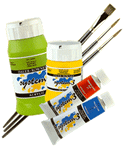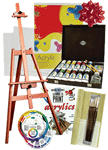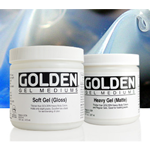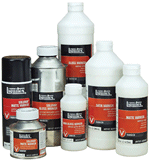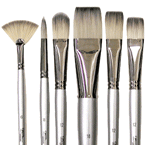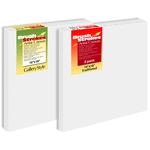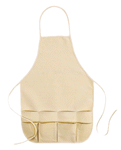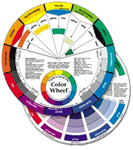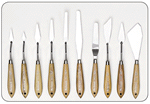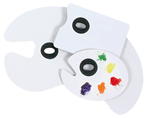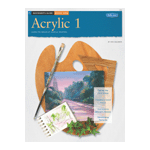Liquitex Paint Additives
Attributes
Liquitex Paint Additives are similar to acrylic mediums in that they are mixed into acrylic paint and mediums to change consistency, thickness, transparency, sheen, drying time and absorption rate. However, they are different in that they do not contain acrylic polymer emulsion and therefore have no binding qualities inherent within them.
SLOW-DRI FLUID RETARDER
Attributes
- Increases "open" time of acrylic paint. Reduces paint skinning over on palette.
- Increases blending time, making blending of colors and detail brushwork easier.
- Mix with Liquitex Acrylic Paints and Mediums to retard drying time up to 50%.
- Fluid consistency, made to be used with Liquitex Medium Viscosity Concentrated Artist Color and Medium Viscosity Mediums.
- May also be used with Liquitex High Viscosity Artist Color and High Viscosity Mediums, however thickness of paints and mediums will be reduced.
Directions
- Do not mix more than 25% per volume into paint and mediums or paint may not fully dry.
Application
Refer to Part I Airbrush,Varnishes and Watercolor and Part 2 and the following Applications & Techniques Sections: Brushwork: Blending (Wet into Wet), Dry Brush and Fine Line Detail
SLOW-DRI GEL RETARDER
Attributes
- Similar to Slow-Dri Fluid Retarder, except in gel (high viscosity) thickness
- Gel consistency, designed to be used with Liquitex High Viscosity Artist Color and High Viscosity Mediums.
- May also be used with Liquitex Medium Viscosity Concentrated Artist Color and Medium Viscosity Mediums, however thickness of paints or mediums will be increased.
Directions
Do not mix more than 25% per volume into paint and mediums or paint may not fully dry, have poor adhesion and excessive shrinking.
Application
Refer to Part II and the following Applications & Techniques Sections: Brushwork: Blending (Wet into Wet).
FLOW-AID FLOW ENHANCER
Attributes
- Use in conjunction with any acrylic medium or color when increased flow and absorption and decreased film tension and friction are important.
- A flow enhancer that improves the flow, absorption and blending of any water-soluble paint (i.e. acrylic paint), medium, ink or dye.
- Minimizes brush marks, by reducing friction of paint application.
- Does not contain binder. Over thinning of acrylic paint with Flow-Aid and applying to a non-absorbent surface (i.e. gessoed canvas) may result in poor adhesion. Always make a test piece for your particular application and surface.
- On non-absorbent surfaces, will increase the fluidity and open (drying) time of the paint.
- On absorbent surfaces, will act as a stain, dye or watercolor.
Directions
- Flow-Aid is a concentrate. Dilute with water before mixing into paint. Distilled water is best, since quality of tap water varies.
- Minimum dilution: 1 part Flow-Aid to 10 parts water to achieve Flow-Aid Water.
- Normal dilution: 1 part Flow-Aid to 20 parts water to achieve Flow-Aid Water. Do not use undiluted. Using undiluted may result in poor paint adhesion, cause paint to crack, remain tacky and become water sensitive.
- Do not shake or rapidly stir. This will increase foaming of Flow-Aid. Wait until foaming has subsided before using.
- Absorbent surfaces: Use as much Flow-Aid water as necessary. The Flow-Aid Water paint mixture will be absorbed by the support.
- Mix Flow-Aid Water into water based paint. Do not mix Flow-Aid with turpentine or oil paint.
- Do not use Flow-Aid in marbling, as this technique requires that the surface tension of the water film be maintained.
Application
Refer to Part I Varnish and the following Part 2 Applications & Techniques Sections: Airbrush, Watercolor, Brushwork: Blending (Wet into Wet), Dry Brush and Fine Line Detail
LIQUITHICK GEL ACRYLIC THICKENER
Attributes
- A thickening gel for water soluble acrylic paint and mediums.
- Used in small amounts, produces handling characteristics very close to that of oil or encaustic paint.
- At higher concentrations can thicken paint or mediums to "cake" or sculptural consistency.
- Drying time will be between 24 hours to 7 days depending upon amount of Liquithick added to paint or medium.
- Liquithick does not increase transparency.
- Liquithick produces a matte surface sheen to dried paint film.
- Paint and medium shrinkage will occur in proportion to the amount of Liquithick added.
- Adding gel medium increases strength and flexibility.
Directions
- Start by adding a very small amount of Liquithick to paint or medium and mix well with a palette knife. The proper proportion will vary with color and desired effect.
- Proportions of 1 part Liquithick to 20 or 25 parts paint or medium will change the handling characteristics.
- Continue adding Liquithick Slowly until the desired viscosity is achieved.
- Add only enough for desired effect and do not exceed 1 to 4 ratio as excessive shrinkage and cracking may occur.
Application
Refer to Part 2 Applications & Techniques: Brushwork - impasto
MARBLEEASE MARBLING FLUID
Attributes
Add to Medium Viscosity Concentrated Artist Color to produce the proper spread and control of colors when they are floated on top of a marbling "size", such as liquid starch, gum tragacanth, Irish Moss, etc.
Directions
- Mix Marble Ease with Medium Viscosity Concentrated Artist Color until they will drip easily from a brush, painting knife or eye dropper. The amount of medium needed varies from color to color.
- If the color does not spread easily, add more MarbleEase .
- If the color spreads too much add a small amount of water and/or more color to the MarbleEase medium and color mixture until the desired degree of control is achieved.
- Start with 50/50 mixture of color and medium and then add more medium as needed.
- MarbleEase is flammable. Use in a well ventilated space away from sparks or flame.


